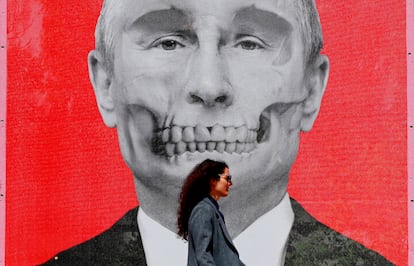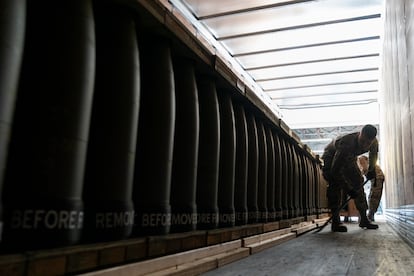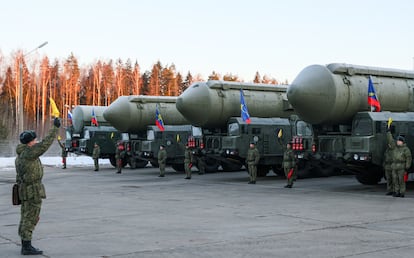Putin’s war in Ukraine enters global spiral of unforeseeable consequences
Russia’s growing aggressiveness and Biden’s decision to stand up to it are pushing Europe to the brink of becoming the scenario of a clash between nuclear powers

Russia’s war against Ukraine has entered a spiral that goes beyond the clash between two states and runs the risk of acquiring international proportions. Russian President Vladimir Putin’s military fiasco, the victory-mode morale of Ukrainian President Volodymyr Zelensky and the geostrategic interests of US President Joe Biden are guiding the conflict towards a new phase that could be even more deadly than the initial one and with potentially much more serious reverberations for the rest of the European continent.
The two sides are facing a decisive week, with the date of May 9 marked in red as a possible high point of the Russian offensive or as a pause for peace negotiations. But the most likely scenario, according to sources in Brussels and Washington, is that the war will drag on and that Russia will keep up an escalation that increasingly includes the threat of using its nuclear arsenal.
“The Russian government loves anniversaries and they would probably like May 9 to be a milestone in the conflict,” NATO sources point out, alluding to the upcoming commemoration of the USSR’s victory over Nazi Germany in 1945. The symbolic date, according to these sources, would be propitious for the Kremlin to try to claim its success in the invasion of Ukraine or to offer a path to negotiation. “But most likely, Russia will not be able to do either one thing or the other. The battle continues and the Ukrainians are convinced that they can win”, add the same sources.
The spiral of aggressive rhetoric by Putin’s government and, above all, its continuous non-rhetorical violence in recent weeks, raise fears of a deepening conflict and an extension of international ramifications. The Western allies are supplying the Ukrainian army with increasingly abundant and sophisticated weapons so that it can defend itself against the incessant Russian strikes.

Allied sources acknowledge that these deliveries will require permanent participation by the West in the maintenance and management of the supplied equipment, as well as in the training of the Ukrainian military personnel in charge of using it. Both factors will increase the risk of a fortuitous or deliberate attack by Putin’s army. Ukrainian soldiers are already traveling to US bases in Germany and other countries to be trained, the Pentagon has announced.
Objective: Decimate the Russian army
Washington has also set itself the goal of helping the Ukrainian president, Volodymyr Zelenskiy, to decimate the Russian army until it is unable to undertake an invasion like the one that began on February 24. And US President Joe Biden is raising US aid to Kyiv to levels that already equal America’s annual spending during its campaign in Afghanistan.
Putin has threatened, for his part, to resort to never-used weapons to respond to Western involvement that, according to Moscow, is beginning to border on co-belligerence. And Russia’s foreign minister, Sergei Lavrov, on Monday accused NATO of having embarked on a war against Russia through the intermediation of Ukraine. He warned that the risk of a nuclear conflagration is “serious, real.” “We must not underestimate it,” he added threateningly.

Russia is also threatening to extend the conflict to Moldova, taking advantage of the presence of its so-called peacekeepers in the separatist region of Transnistria, which would open up another front on the southwestern flank in Ukraine. And, for the first time, Russian authorities are beginning to use the term “war” to describe a conflict that until now they have described as a “special military operation.” Western sources point out that Moscow’s toughest wing would be in favor of openly declaring war against Ukraine, a move that would involve the general mobilization of the Russian adult population for possible conscription.
Allied sources attribute the growing aggressiveness of the Kremlin’s rhetoric to its continuing struggles on the battlefield. “Raising your voice so much right now is a display of weakness rather than strength,” these sources point out. Jamie Shea of the Friends of Europe think tank and a former NATO official agrees that Russian protests against Western arms supplies are a clear signal that Moscow fears military failure in Ukraine. “The Kremlin knows that it will have to scale down its offensive in the Donbas region and in the Black Sea when the Ukrainian army starts using sophisticated, high-tech weapons, such as Switchblade drones, missile launchers or air defense and radar systems.”
Even the European Union, initially reluctant to the idea of getting involved in a military resolution of the conflict, is becoming more and more combative. “Russia’s aggression is a direct threat to our security, and we will make it a strategic failure,” said European Commission President Ursula von der Leyen this week. “This is a defining moment, our response will decide the future of both the international system and the global economy,” she predicted during an official visit to India.
Washington sets the pace
But it is Biden who is setting the pace in the arms race in favor of the Zelenskiy government. According to allied sources, Washington’s leap forward has come after “the lack of stamina by the Russian army became evident” as well as the apparent shortcomings of the Kremlin’s intelligence services. “Weapons from the West began to enter Ukraine on February 25, the day after the start of the war, and there is still no record that Russia has hit even one of the Western shipments,” says an allied source.
“It is clear that there is a change in strategy in Washington and in many European capitals,” Richard Gowan, an analyst at the independent organization International Crisis Group, explains by phone from New York. “Let’s say that now a crack has opened through which they see a possibility to go further and end up weakening Russia to prevent it from making incursions into other countries in the future.”
The US shift on the Ukrainian front began last Monday with Defense Secretary Lloyd Austin saying, after a visit to Kyiv, that he hopes the war will serve to “see Russia weakened.” It continued on Tuesday with Austin taking the lead of a 40-nation alliance at the Ramstein military base in Germany. And it reached its peak on Thursday, with Biden’s request to Congress to approve $33 billion in new aid for Ukraine. These three milestones can be viewed as signs of a change in what the United States expects from the conflict: from a battle to defend a fragile democracy and prevent its dismemberment, to an escalating conflict that implies an increasingly direct confrontation between Washington and Moscow.
If the total amount pledged this week is added to the $13.6 billion in aid approved earlier this month by Congress, the United States has sent $46.6 billion in the first four months of the year to Ukraine, more than was spent annually on Afghanistan (about $40.8 billion on average, according to the Pentagon). That announcement is also the unequivocal sign that the White House is working with a long-war scenario. One of its senior officials acknowledged on Thursday, anonymously, that this “historic” amount of aid to a foreign country will guarantee “aid for five more months of conflict, at the least.”
Ian Lesser, executive director of the Brussels branch of the German Marshall Fund think tank, believes that if Austin’s goal of weakening Russia is confirmed “it would mean that Washington and NATO are contemplating a lasting period of confrontation and risk in connection with Russia.”
The risk of a bitter power
The optimism of the West, and of the Biden administration in particular, about the defeat of Russia and its definitive weakening worries some analysts. “I think it is a mistake to make Russia’s weakness the main target. We should prevent it from becoming an angry, bitter and dangerous power, as Germany was in the 1920s, ”says Michael O’Hanlon, director of foreign policy research at the Brookings Institution and an expert on American defense and national security. “And I don’t need to remind anyone what came after that humiliation.”
Gowan is also in favor of Western powers continuing to send a message to Putin that there is still an option for a negotiated exit, even though at this moment “both parties are convinced of the possibility of their victory.” “If the only message the Kremlin hears is that the United States is ready for a long war, Moscow is likely to double down, making a long conflict entirely unavoidable,” he says.
Sources at NATO acknowledge that “there is the possibility that Putin will opt for escalation.” And Brussels observers are wary of a Russian president who, according to these sources, “often does not seem to be well informed by his commanders about what is happening on the battlefield.”
Two months after the start of the war, the Russian Army reportedly only has 90 battalions on Ukrainian territory, with another 20 back in Russia to resupply, according to NATO sources. The same sources calculate that at the beginning of the invasion there might have been up to 130 battalions, which would indicate that, between casualties and withdrawals, there are 30% fewer Russian troops left in Ukraine.
Western intelligence also considers that the Kremlin has exhausted its arsenal of precision weapons and does not have the financial or technical capacity to equip itself with missiles that cost about $2 million (€1.9 million) per unit. “Russia is resorting to old-style artillery and to indiscriminate attacks that instead of destroying a specific objective take out an entire neighborhood of civilians,” allied sources point out.
Nuclear attack threats
The size of the disaster led the Kremlin last week to resume its threats of nuclear attack, put forward at the beginning of the conflict. “We cannot speculate on what the Russians will or will not do, but the fact is that they are a nuclear power and we do not know if it is all a bluff,” acknowledge NATO sources. The same sources consider it “tremendously irresponsible that a nuclear power is embarking on this type of rhetoric,” although they stress that the allusions to a possible nuclear attack come more from Putin’s media environment than from the regime itself.
Andrei Kolesnikov, head of Russian policy at the Carnegie think tank in Moscow, considers that references to nuclear catastrophe “are part of the language of hate and even official sources now easily resort to talking about topics that until recently were taboo.” For Kolesnikov, such rhetoric “reveals a certain degree of frustration.” But he warns against the risk of ignoring it. “Putin can do anything: no one believed he could annex Crimea, and certainly no one thought he could launch a ‘special operation,’ but he did.”
In that sense, the Pentagon spokesman, John Kirby, said on Wednesday: “Nobody wants to see this war escalate any more than it already has. Certainly, nobody wants to see, or nobody should want to see it escalate into the nuclear realm.” Biden, for his part, described Moscow’s atomic threats as “irresponsible.” The threats are not true, he said, but “they do concern me, because it shows the desperation that Russia is feeling about their abject failure in being able to do what they set out to do in the first instance.”

Ian Lesser believes that the nuclear risk is “small, although not zero.” The director of the German Marshall Fund in Brussels sees a much greater risk of a “conventional clash between NATO and Russia, either intentionally or, more likely, due to an incident in a military operation. And that could cause an escalation.” Experts also point out that the friction zones for this spark are not limited to the Ukrainian territory and its surroundings. “It could be on the Polish border, in the Baltic or in the Black Sea, but it is even conceivable in the Mediterranean, in Syria, Libya or in the Sahel region, where Russian and Western forces are in contact,” notes Lesser.
“Russia knows that it cannot win a nuclear war and that the US and NATO have capabilities in that area that are much more than equal to Russia’s,” says Jamie Shea. This analyst, who was also a NATO spokesman during the Kosovo war, believes that Moscow’s nuclear gestures not only seek to intimidate the West. “It is also an internal propaganda tool to create the false impression in public opinion that Russia is waging an existential war in Ukraine, in which its own survival is at stake in the face of Western aggression.”
For Shea, this story “sets the stage for more mandatory recruitment as Russian Army casualties in Ukraine mount.” This decision may be very unpopular with a Russian population that Moscow keeps gagged or hypnotized based on propaganda about an alleged “de-Nazification” of Ukraine.
Putin’s propaganda will reach its peak during the military parade scheduled for May 9, which this year takes place in the midst of a new war. That same day, the EU will commemorate the anniversary of the Schuman Declaration, the founding text of the European club. And in the European Parliament, in Strasbourg, the conference on the Future of Europe will come to an end, an exercise in citizen reflection that aims to adapt the Union to the reality of the 21st century.
It is an unlikely scene: a Europe at war versus EU forums of dialogue and concord on the same day. Although if we take the dream further, it is also possible to imagine a post-war period in which a Russia freed from its authoritarian drift and with its nuclear arsenal subject to international standards could join the old project of building a continent of peace and prosperity from Lisbon to Vladivostok. The reconciliation of Germany and France also seemed like a pipe dream when Robert Schuman opted for European integration in 1950, just five years after the defeat of Adolf Hitler.
Tu suscripción se está usando en otro dispositivo
¿Quieres añadir otro usuario a tu suscripción?
Si continúas leyendo en este dispositivo, no se podrá leer en el otro.
FlechaTu suscripción se está usando en otro dispositivo y solo puedes acceder a EL PAÍS desde un dispositivo a la vez.
Si quieres compartir tu cuenta, cambia tu suscripción a la modalidad Premium, así podrás añadir otro usuario. Cada uno accederá con su propia cuenta de email, lo que os permitirá personalizar vuestra experiencia en EL PAÍS.
¿Tienes una suscripción de empresa? Accede aquí para contratar más cuentas.
En el caso de no saber quién está usando tu cuenta, te recomendamos cambiar tu contraseña aquí.
Si decides continuar compartiendo tu cuenta, este mensaje se mostrará en tu dispositivo y en el de la otra persona que está usando tu cuenta de forma indefinida, afectando a tu experiencia de lectura. Puedes consultar aquí los términos y condiciones de la suscripción digital.
More information
Últimas noticias
New York enters the era of Zohran Mamdani
Welcome to the post-religion era: The idea of Christianity as the absolute truth has become obsolete
‘I thought you would like it’: The risky sexual practice popularized by TV shows and TikTok
The digitalization of tourism: ‘They promise experiences and gave us the worst possible one’
Most viewed
- Sinaloa Cartel war is taking its toll on Los Chapitos
- Reinhard Genzel, Nobel laureate in physics: ‘One-minute videos will never give you the truth’
- Oona Chaplin: ‘I told James Cameron that I was living in a treehouse and starting a permaculture project with a friend’
- Why the price of coffee has skyrocketed: from Brazilian plantations to specialty coffee houses
- Silver prices are going crazy: This is what’s fueling the rally









































